| Bonsai is a process to produce a live dwarf specimen of a big tree. A bonsai should represent a mature and old tree, not only the age, but also the sign of natural wounds a plant should bear in wilderness. Bonsai first appeared almost 1000 years ago, in China. There it was called then, pun-sai. From there it went to Japan and there it evolved more. Bonsai is a mixture of poetic dream, handiwork of an artist and success of a horticulturist. Bonsai practically comes under artwork, the only difference from other art that, it is live art |
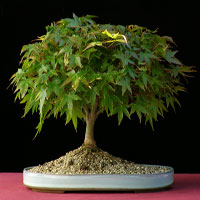 |
BROOM STYLE
The broom style, or Hokidachi, is employed for trees with extensive, fine branching, often with species like elms. The trunk is straight and upright. It branches out in all directions about 1/3 of the way up the entire height of the tree. The branches and leaves form a ball-shaped crown which can also be very beautiful during the winter months.
|
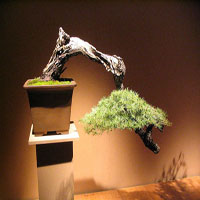 |
CASCADE STYLE
Cascade-style, or Kengai, bonsai are modeled after trees which grow over water or on the sides of mountains. The apex, or tip of the tree in the Semi-cascade-style, or Han Kengai, bonsai extend just at or beneath the lip of the bonsai pot; the apex of a (full) cascade style falls below the base of the pot.
|
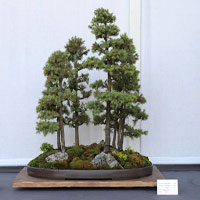 |
FOREST STYLE
The group or forest style, or Yose Ue, comprises a planting of several or many trees, and typically an odd number, in a bonsai pot. The trees are usually the same species, with a variety of heights employed to add visual interest and to reflect the age differences encountered in mature forests.
|
|
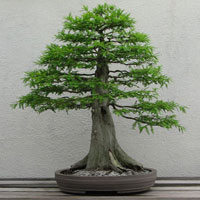
|
FORMAL UPRIGHT STYLE
The formal upright style, or Chokkan, is characterized by a straight, upright, tapering trunk. Branches progress regularly from the thickest and broadest at the bottom to the finest and shortest at the top.
|
|
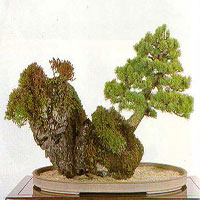
|
GROWING IN A ROCK
The growing-in-a-rock, or Ishizuke, style means the roots of the tree are growing in soil contained within the cracks and holes of the rock. The rock may serve as a simple container, with the tree escaping the container and forming its own shape. Alternatively, the tree may show a definite relationship to the rock's shape, growing close to the rock and following its cotours.
|
|
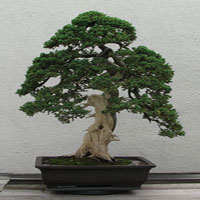
|
INFORMAL UPRIGHT STYLE
The trunk and branches of the informal upright style, or Moyogi incorporate visible curves, but the apex of the informal upright is always located directly above the trunk's entry into the soil line. Similar to the formal upright style, branches generally progress regularly from largest at the bottom to smallest at the top, although this progression may be broken where the irregular shape of the trunk would make a branch abnormally prominent or obscure.
|
|
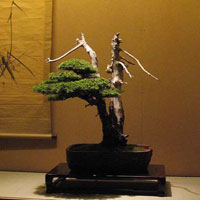
|
SHARI STYLE
The Shari style, or Sharimiki, style involves portraying a tree in its struggle to live while a significant part of its trunk is bare of bark. In nature, trees in the Sharimiki style are created by lightning or animals eating the bark.
|
|
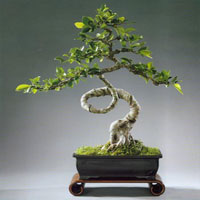
|
LITERATI STYLE
The literati style, or Bunjin-gi, bonsai is characterized by a generally bare trunk line, with branches reduced to a minimum, and typically placed the top of a long, often contorted trunk. This style derives its name from the Chinese literati who created Chinese brush paintings like those found in the ancient text, The Mustard Seed Garden Manual of Painting. Their minimalist landscapes often depicted trees growing in harsh conditions, with contorted trunks and reduced foliage. In Japan, the literati style is known as bunjin-gi (???[84]?). (Bunjin is a translation of the Chinese phrase wenren meaning "scholars practiced in the arts" and gi is a derivative of the Japanese word, ki, for "tree").
|
 |
RAFT STYLE
Raft-style, or Netsuranari, bonsai mimic a natural phenomenon that occurs when a tree topples onto its side, for example, from erosion or another natural force. Branches along the top side of the trunk continue to grow as a group of new trunks. Sometimes, roots will develop from buried portions of the trunk. Raft-style bonsai can have sinuous, straight-line, or slanting trunks, all giving the illusion that they are a group of separate trees—while actually being the branches of a tree planted on its side.
|
|
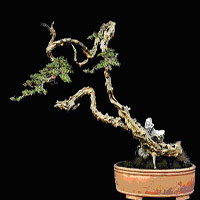
|
ROOT OVER ROCK STYLE
The root-over-rock style, or Sekijoju, is a style in which the roots of the tree are wrapped around a rock. The rock is at the base of the trunk, with the roots exposed to varying degrees as they traverse the rock and then descend into the soil below.
|